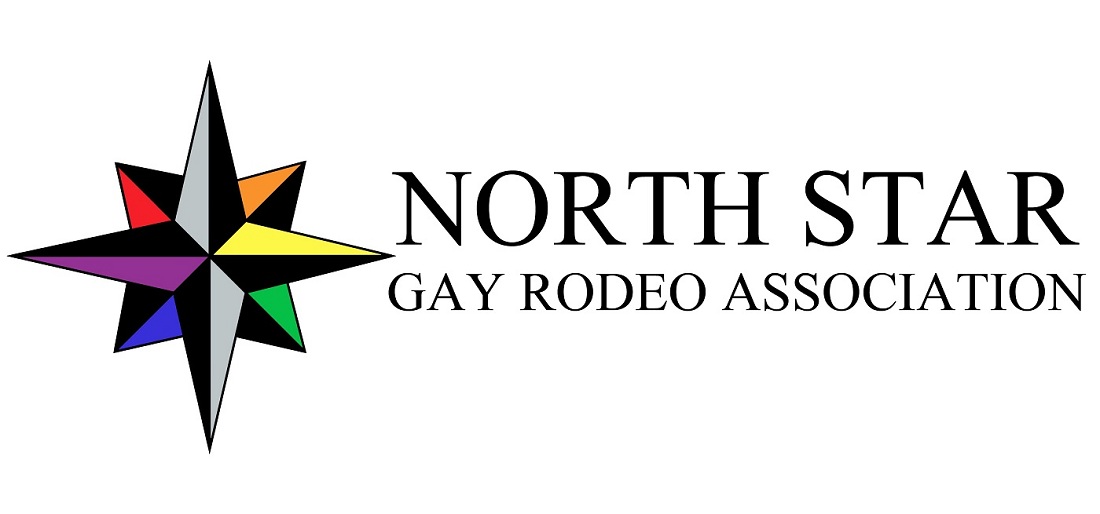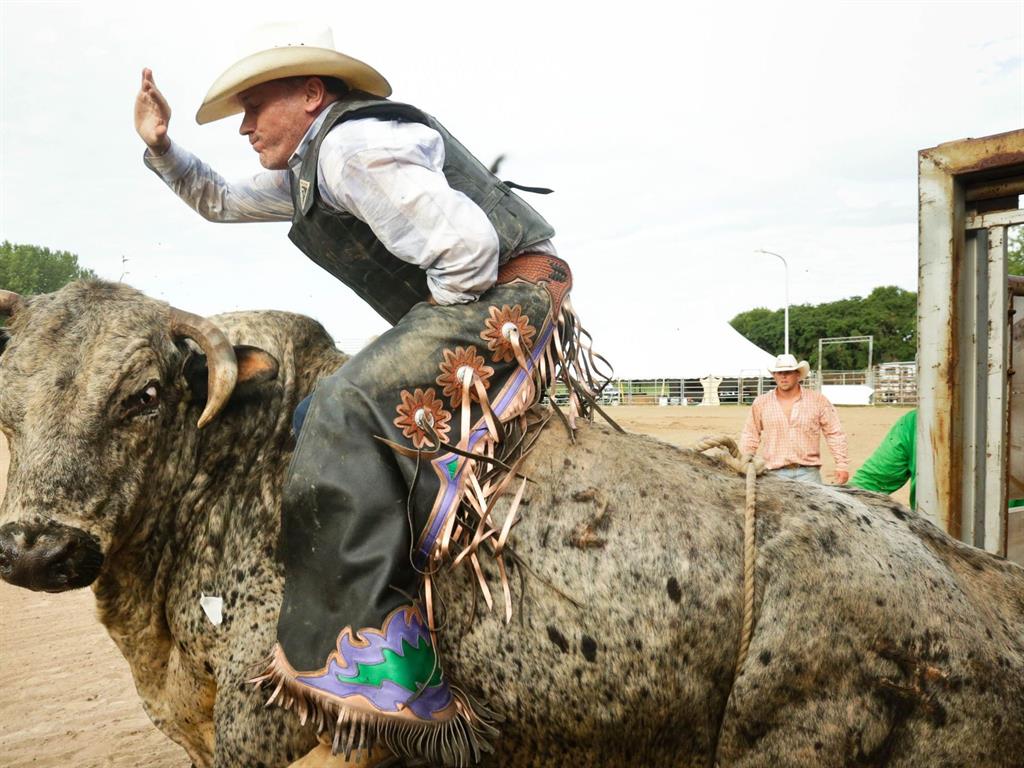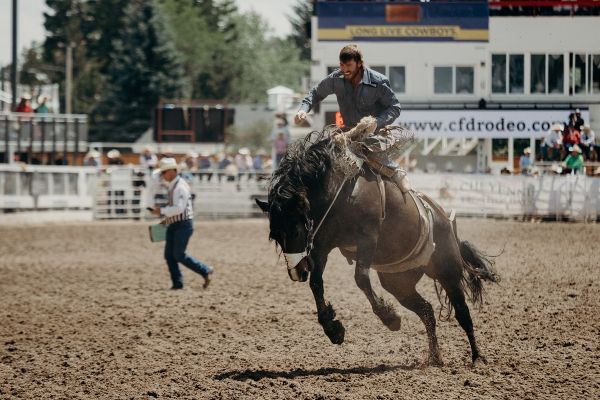

Rodeo Events
Rough Stock Events
Bull Riding
Historically the most dangerous event in Rodeo. The contestant uses an approved rigging with flat braided rope with a braided hand grip, a loop and a bell. This is wrapped around the chest of the Bull, and the rider's hand is tied into the hand grip. The rope can be worked with Rosin and Saddle soap to provide a very sticky grip to assist with their hold. Stock contractor flanks the bull with a soft cotton rope around the back end that signals the bull to buck when released from the chute. When the contestant is tied in and ready, they signal for the chute to be open. Rider must stay mounted and in control for six seconds, may only use one hand to hold on, and the other must not touch the animal or themselves. Rider is scored 50% on their ability and skill, and 50% on the skill of the bull.
Steer Riding
An entry level event for new cowboys and cowgirls. Contestant uses an approved rigging that has a braided flat rope with a flat braided hand grip, and a loop with a bell. This rigging is looped around the chest area of the animal. A steer is a less aggressive animal and skill set. The Stock Contractor flanks his animals with a soft cotton rope around the back end of the bull that signals the animal to buck. When contestant is tied in and ready, they signal for the Chute to be opened. They must stay mounted and in control for six seconds. They can only ride one handed, and the free hand cannot touch themselves or the animal. Rider is scored 50% on their ability and skill, and 50% on the skill of the animals. Spurs can be used to enhance the performance of the Bull, but they must not be sharp and must be locked rowels. Our Judges verify these on each contestant prior to their ride.
Chute Dogging
A fast and skillful event of a Steer versus a Cowboy or Cowgirl. Contestant must lead the steer from the chute across the white line, giving the steer the advantage. Once the judge has whistled the steer is across, the contestant must use their skill and strength to "dog the steer".This is a traditional safe method to wrestle the steer to the ground, on its side with all four legs clear from beneath it. A timed event, the fastest time will win.
Ranch Saddle Bronc Riding
Biginning with the 2017 rodeo season, Ranch Saddle Bronc Riding (sometimes abbreviated to Ranch Bronc Riding) was added to the list of optional events. In this event the horse is fitted with a full saddle. The rider holds onto a soft rope which is fastened to the horse's head with a special halter. The rider can use their free hand to hold onto the saddle, unlike the regular saddle bronc ride where the rider must not touch the horse or rider's body with his or her free hand. All other rules generally follow those of Bareback Bronc Riding above. This video is from a regular non-gay rodeo. It will be replaced after we obtain a video from a gay event.
Roping Events
Gay rodeo presents three roping events with one designed for beginners. The other two can be costly, because your success depends on a very good horse. Many roping horses sell for $10,000 and up. These events always begin with the contestant in a “roping box.” An imaginary start line runs across the front of the roping box and the chute where the calf or steer is held. Should the contestant cross this line, called the “barrier”, before the calf or steer clears the chute, a 10-second penalty shall be assessed and added on to the time.
Calf Roping on Foot
A great event for new Cowboys and Cowgirls. Contestant ropes a young calf from the roping box. The loop must go over the calf head and then catch any part of the body, slack is then pulled, and rope is released.
Mounted Break-Away Roping
Cowboys and Cowgirls compete in this event with their trained horse, and a calf. They tie the end of their rope to their saddle horn with a piece of string. Contestant rides horse out of the roping box, and must throw their loop over the calf head and catch any part of the body, slack is pulled from the rope, breaking the string and releasing the rope. When the flagged end of the rope breaks away from the saddle, time is stopped.
Team Roping
A traditional event composed of a team of two (Cowboys and/or Cowgirls) and a roping steer. A roping steer is extensively trained in this event. One contestant begins from the header box and the other from the heeler box. Contestants ride their horses out of the roping boxes as the steer is released, the header will throw their rope's loop at the horns of the steer, and once caught will dally their rope to their saddle horn. They will turn their horse and the steer in a counterclockwise motion, causing the steer's hind end to swing out, so the Heeler can throw their loop at the hind legs of the steer. Once the heeler has the loop set, and the steer steps into the loop, they pull slack, dally their rope to their saddle horn, back up to contain the steer, and face the steer to stop time.
Speed Events
Speed and agility are two highly prized qualities in these contestant’s horses. These three speed events pit the horse, under the skillful hand of it’s rider, against the clock. Negotiating the prescribed pattern is a test of the rider’s skill and the horse’s speed and agility. A running start is permitted in these events and the fastest time wins.
Barrel Racing
Horse and rider compete for fastest time running a cloverleaf pattern around three barrels. A running start is allowed. A five second penalty is assessed for knocking over a barrel. Disqualification will take place if the horse and rider break the required pattern.
Pole Bending
Horse and rider compete for fastest time working a zigzag pattern through six equally spaced poles. A running start is allowed. A five second penalty will be assessed for knocking a pole down. Disqualification will take place if the horse and rider break the required pattern.
Flag Race
Horse and rider compete for fastest time running a pattern similar to the barrel race. A pole is exchanged for barrel number three. A flag is placed in a bucket on the first barrel. A running start is allowed. Horse and rider must run the pattern, pick up the flag and stick it in the second bucket. A five second penalty is assessed for knocking over the first bucket or the pole. Disqualification will take place if the horse and rider break the required pattern, miss the flag, miss sticking the flag in the second bucket, or knocks over the second bucket or barrel.
Camp Events
Whenever a group of cowhands get together for a good time, hell is going to be raised! Cowhands generally have their own definition of fun and challenge. After a few beers and some serious ego pumping, it is amazing what a group of hands can come up with! Prerequisites for participation are a willingness to eat dirt and the ability to hold your own with an ornery steer or goat. Sixty percent of gay contestants get their start in these three events and the old-timers stay in because the payoffs (or winnings) are the best of all events.
Steer Decorating
A fast event composed of a team of two (Cowboys and/or Cowgirls) and one steer. First contestant brings the steer across the line, second contestant ties a ribbon on the tail, first contestant removes the rope loop from the horns, as second contestant runs to tag the timer behind the chute.
Wild Drag Race
An exciting, yet dangerous event composed of a team of three (Cowboys and/or Cowgirls) and a steer with a halter and lead rope. One team member leads the haltered steer to the finish line, one member assists, and the contestant dressed in drag readies to mount the steer. Once the steer is across the line, the drag must mount the steer and ride it back across the finish line.
Goat Dressing
An athletic event, composed of a team of two (Cowboys and/or Cowgirls) a goat, and a pair of brief style underwear. They must run to the goat (one carries the underwear), catch the goat, put the underwear on the goat (over the tail), and run back to the finish line.
Our Mission
NSGRA is to operate as a tax exempt organization under 501©(3) of the Internal Revenue Code, assisting local communities and charities through support, education, and fundraisers while providing a friendly environment for all persons to participate in and learn about western lifestyles and skills.
